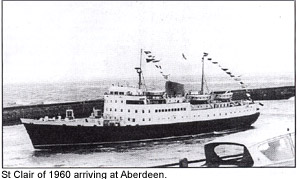
| ColinJ. Smith September 30"' 2002, was a historic day for Orkney and Shetland with the final sailings to the islands of the ships ofP&O Scottish Ferries, prior to their replacement the next day by the new ships of Northlink Ferries. Those final sailings represented the ending of 212 years of unbroken service by P&O and their predecessors, the old "North Company". Their demise was an emotional occasion for islanders and crews alike. |
 |
It was 1833 before the first regular, but infrequent steamship service reached Orkney and 1836 before steamers served Shetland. The first steamship operator was the Lcith & Aberdeen Steam Yacht Company (L&ASYC) but the North Company itself began life as the Leith and Clyde Shipping Company in 1790, becoming the Aberdeen, Leith & Clyde Shipping Company (AL&C) in 1824. They began steamship services in 1821 and ten years later introduced the Sovereign a steamship so wonderful that one correspondent of the day noted that the vessel was "A specimen of speed for which we were not prepared" In 1833, the first weekly summer service ventured to Kirkwall, whilst 1836 witnessed the introduction of the service from Newhaven to Lerwick via K-irkwall. In 1838, the AL&C secured the Shetland mail contract, accompanied by the introduction of a year round Lcith - Aberdeen service and 1851 saw the inauguration of year round Lcith, Aberdeen - Caithness and Kirkwall services, whilst year round services to Lerwick commenced in 1858. Expansion was rapid and the Company even operated as far west as Loch Eriboll and Stomowayforatimefrom 1861. In 1867, the Company introduced the St Magnus (I), their last paddle steamer and their first "saint". In 1875 the AL&C became the North of Scotland, Orkney & Shetland Steam Navigation Company - conveniently shortened to The North Company. In 1856, John Stanger linked Scrabstcr and Stromness using the steamer Royal Mail and in 1865, George Robertson operated the Express on the same route. Railway competition appeared in 1877 with the John 0' Groat, which remained in service until 1882 when the route became part of the expanding North Company. St. Glair of 1960 arriving at Aberdeen. empire, operated by their new vessel St Olaf, followed by the first St Ola in 1892, setting the trend for the next 110 years. In 1891, with the St Nicholas inaugurating the "direct" route from Leith and Aberdeen to Lcrwick, with no intermediate calls, the company's development was complete and the pattern of services, which remain today, had been established. In 1886, the North Company offered cruises to Norway, using the St Sunniva(l). However, as larger companies and cruise specialists entered the fray, the North Company withdrew from this market, ceasing regular cruises altogether in 1908. Upon outbreak of the Great War, the company operated eight vessels. Many North Company ships were requisitioned for war service, prompting acquisition of a range of replacement vessels, and the Company lost the Express, in a collision off France, the St Margaret, a victim of enemy torpedoes near the Faroe Islands and the St Magnus (II), sunk off Peterhead in February 1918. The inter war years saw the introduction of the yacht-like St Margaret, formerly David MacBrayne's Chieftain, the third St Magnus, the cargo vessel St Clement, and in 1937 the second St Clair, the company's last steamship. Services were interrupted by the loss of the St Sunniva (I) on Mousa in 1930 and her eventual replacement by the second St Sunniva, whilst the North Company's black funnel colours were replaced by yellow in 1937, which stayed with the company for almost forty years. For the North Company, World War 2 effectively started in 1938 being heavily involved in military preparations in Scapa Flow and at Lyncss and in troop movements to the islands. During the conflict, the North Company lost four vessels, the St Fergus (1913), St Catherine (II), and the St Clement (I), with the most dramatic loss being that of the St Sunniva (II) which foundered off Newfoundland whilst on convoy duties. When peacetime returned, a new St Ninian replaced her worn out predecessor. Both she and the new St Ola (1951) were passenger and cargo vessels whilst the new St Clement (II), and St Rognvald (III) and the second hand St Magnus (V) were cargo carriers with capacity for 12 passengers. A new Earl of Zetland took up the inter island services in Shetland in 1946 and remained in service until the advent of the Shetland Islands Council ro-ro ferries in 1975. With the steam era at an end, the company changed its name to the "North of Scotland, Orkney & Shetland Shipping Co. Ltd." in 1953. |
|